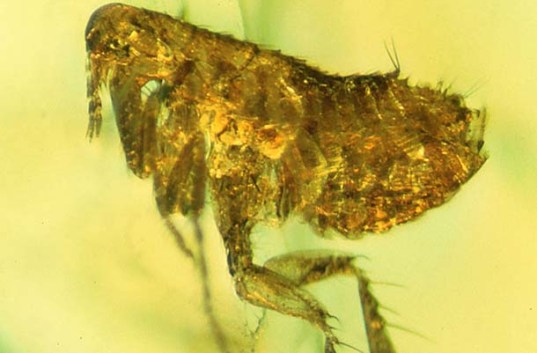Bacteria From Ancient Flea Believed to be Related to the Bubonic Plague
Researchers believe that the bacteria, found in the fossil, are closely related to the bacteria thought to be responsible for the Black Death – Yersinia pestis.
The plague wiped out more than half of the population of Europe in the 14th century, when three phases of the disease, bubonic, septicemic and pneumonic, spread across the continent and Asia, killing an estimated 75 to 200 million people. Although scientists are not 100 percent certain of the relationship between the bacteria and Yersinia pestis, a close examination of the find suggests that they are indeed related. When a flea used an infected animal as its food, the bacteria taken from the animal’s blood remained in the flea, making it impossible to feed again, as it would block the flea’s stomach.
George Poinar Jr., one of the most prominent experts on flora and fauna preserved in amber, says the shape of the bacteria found in the flea and their location is very similar to the shape and locations in fleas where modern-day plague bacilli are found. Moreover, “the presence of the bacteria on the proboscis is “consistent with the method of transmission of plague bacteria by modern fleas”. Scientists have discovered a flea preserved in amber with tiny bacteria that could have eventually evolved into the dreaded strain of the bubonic plague.
The amber containing the flea was found in amber mines at what is now the Dominican Republic, between Puerto Plata and Santiago.
Under a microscope, researchers have been able to identify an organism showing numerous telltale hallmarks of the bubonic plague bacteria – Yersinia pestis.
Previous genomic studies suggest that the flea-plague-vertebrate cycle dates back to only about 20,000 years ago.
However, Poinar points out, Yersina pestis has existed as several different and distinct strains, several of which are extinct at this point in time. “
Plague may have played a larger role in the past than we imagined”,
he continued. The bacteria were discovered on the proboscis of the flea, as well as inside its rectum. As stated by lead author of the study, Poinar, if this is indeed true, there is “no doubt” that it was infecting animals 20 million years ago, and possibly drove a few of them to extinction.
“If this is an ancient strain of Yersinia, it would be extraordinary”, said Poinar, an entomology researcher in the College of Science at Oregon State University. At the time when the flea was trapped in the semi-precious stone, the geographic area would have been a tropical forest with high humidity.
Today, bubonic plague can infect and kill a wide range of animals as well as humans.








